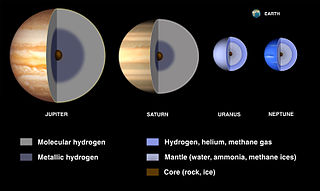
Chondrites are stony (non-metallic) meteorites that have not been modified due to melting or differentiation of the parent body. They are formed when various types of dust and small grains that were present in the early solar system accreted to form primitive asteroids. They are the most common type of meteorite that falls to Earth with estimates for the proportion of the total fall that they represent varying between 85.7% and 86.2%. Their study provides important clues for understanding the origin and age of the Solar System, the synthesis of organic compounds, the origin of life and the presence of water on Earth. One of their characteristics is the presence of chondrules, which are round grains formed by distinct minerals, that normally constitute between 20% and 80% of a chondrite by volume.

Carbonaceous chondrites or C chondrites are a class of chondritic meteorites comprising at least 8 known groups and many ungrouped meteorites. They include some of the most primitive known meteorites. The C chondrites represent only a small proportion (4.6%) of meteorite falls.

Iron meteorites are meteorites that consist overwhelmingly of an iron–nickel alloy known as meteoric iron that usually consists of two mineral phases: kamacite and taenite. Iron meteorites originate from cores of planetesimals.

Pallasovka is a pallasite meteorite found in 1990 near the town of Pallasovka, Russia.

Mbozi is an ungrouped iron meteorite found in Tanzania. It is one of the world's largest meteorites, variously estimated as the fourth-largest to the eighth-largest, it is located near the city of Mbeya in Tanzania's southern highlands. The meteorite is 3 metres (9.8 ft) long, 1 metre high, and weighs an estimated 16 metric tons.
Winonaites are a group of primitive achondrite meteorites. Like all primitive achondrites, winonaites share similarities with chondrites and achondrites. They show signs of metamorphism, partial melting, brecciation and relic chondrules. Their chemical and mineralogical composition lies between H and E chondrites.
The Brachina meteorite is the type specimen of the brachinites class of the asteroidal achondrites.

IAB meteorites are a group of iron meteorites according to their overall composition and a group of primitive achondrites because of silicate inclusions that show a strong affinity to winonaites and chondrites.
IIICD meteorites are a group of primitive achondrites. They are classified in a clan together with the IAB meteorites and the winonaites.

IVB meteorites are a group of ataxite iron meteorites classified as achondrites. The IVB group has the most extreme chemical compositions of all iron meteorites, meaning that examples of the group are depleted in volatile elements and enriched in refractory elements compared to other iron meteorites.

Brachinites are a group of meteorites that are classified either as primitive achondrites or as asteroidal achondrites. Like all primitive achondrites, they have similarities with chondrites and achondrites. Brachinites contain 74 to 98% (Volume) olivine.
IIG meteorites are a group of iron meteorites. The group currently has six members. They are hexahedrites with large amounts of schreibersite. The meteoric iron is composed of kamacite.
The Bellsbank meteorite is a hexahedrite iron meteorite with abundant schreibersite. It is classified as a member of the IIG group. It was found in Bellsbank, South Africa in 1955.
The Vermillion meteorite is a pallasite (stony-iron) meteorite and one of two members of the pyroxene pallasite grouplet.
The pyroxene pallasite grouplet is a subdivision of the pallasite meteorites (stony-irons).
This is a glossary of terms used in meteoritics, the science of meteorites.

IIAB meteorites are a group of iron meteorites. Their structural classification ranges from hexahedrites to octahedrites. IIABs have the lowest concentration of nickel of all iron meteorite groups. All iron meteorites are derived from the metallic planetary cores of their respective parent bodies, but in the case of the IIABs the metallic magma separated to form not only this meteorite group but also the IIG group.


















